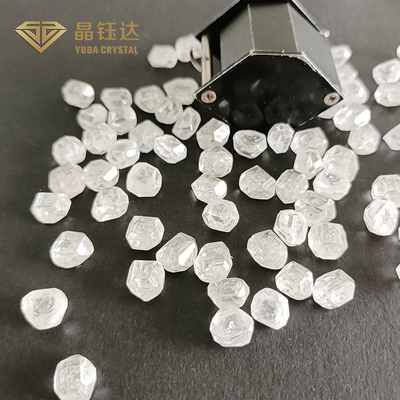DEF Full White 1.0-7.0ct VS SI HPHT Lab Grown Diamonds For Necklace
Lab Created Diamonds Description
Lab-grown diamonds are also known as lab-made diamonds. In the lab, there are two main breeding methods: diamond chemical vapor deposition and the technology of high temperature and high pressure.As lab mature growth of the diamond production technology, its cost is low, and can produce a variety of color gem diamond.
Laboratory diamond growth is an artificial diamond growth environment that simulates natural diamond. It is made of high temperature and high pressure chemical vapor deposition (HTHP) and chemical vapor deposition (CVD) synthesis, also known as the diamond growth. These lab-grown diamonds are real diamonds, which have the same physical properties, chemical composition and crystal structure as natural diamonds. It shares 4C certification standards and has been certified by IGI, GIA and other international authoritative evaluation agencies.
Diamonds are considered the hardest material in the world. Mohs hardness is divided into 10 levels, of which diamond is the highest. Since people know that diamond is composed of pure carbon, more and more people begin to research on diamond under high temperature and high pressure in the laboratory. At present, high temperature and high pressure laboratory diamond raw material industry develops rapidly, widely used in various industries and processing industries.
High pressure High pressure (HPHT) mimics the formation of natural diamond by placing the seed under tremendous mechanical pressure and applying tremendous pressure and high temperatures to the finished carbon. The seeds quickly turn into carbon lattice diamonds and grow layer by layer over several days until they reach the required carat weight.
Parameters Of Lab Created Diamonds
| Product Name |
Synthetic (Lab created) diamond |
| Material |
Lab-grown |
| Color |
DEF |
| Shape |
Round |
| Technology |
HPHT |
| Diamond Cut |
Uncut |
| Payment Terms |
100% Payment In Advance |
| Diamond Carat Weight |
1.0CT-7.0CTS |
| Grade |
VS SI |
| Shipping way |
FedEx, DHL, SF Express, UPS, EMS, TNT etc |
| M.O.Q |
Negotiable |
| Delivery Time |
1-7 Working Days Depends On Quantity |
| Payment Methods |
T/T, PayPal, Western Union, Bank Transfer |
| Used |
Jewelry (necklace,ring,earring) |
| Application |
For Cutting Lab Grown Loose Diamonds |
| Place Of Origin |
Zhengzhou,Heana,China |
Characteristics Of Lab Created Diamonds
Diamonds grown in a laboratory are grown in a laboratory. People use advanced equipment to simulate natural diamond formation of the environment.This distinction forming process is made in laboratory diamonds mined and the main factors. Lab-grown diamonds can be mass-produced in a matter of weeks. Therefore, laboratory breeding of the same size and number of natural diamond is much cheaper.
Synthetic diamond is the product of high and new technology development. Synthetic diamonds are more environmentally friendly and save labor costs.
Natural diamonds are created by nature, is the result of the billions of years of high temperature and high pressure formation. Laboratory growth of diamond is usually produced in laboratory for several weeks. The chemical difference is the same.
So how do you distinguish between laboratory rough diamond and natural diamond?
Laboratory production of the original diamond and natural diamond is not much difference. Even professional gemologists need special equipment to identify them. Through the amplification, professionals will be able to identify the growth of diamond inclusions in laboratory and the nuances of the production.
From a scientific point of view, synthetic diamond and natural diamond exactly the same, the only difference is that the formation of their position
| The Difference Between Lab Diamond And Natural Diamond |
| Attribute |
Lab-Created Diamonds |
Natural diamond |
Distinction |
| Chemical composition |
C(carbon) |
C(carbon) |
No |
| Refractive index |
2.42 |
2.42 |
No |
| Relative density |
3.52 |
3.52 |
No |
| Dispersion |
0.044 |
0.044 |
No |
| Hardness value |
90 GPA |
90 GPA |
No |
| Thermal conductivity |
2*103 W/M/K |
2*103 W/M/K |
No |
| Thermal property |
0.8*10-6 K |
0.8*10-6 K |
No |
| Light transmittance |
DEEP UV TO FAR TR |
DEEP UV TO FAR TR |
No |
|
Resistivity
|
1016 OHM-CM
|
1016 OHM-CM
|
No
|
|
Compressibility
|
8.3*10-13 M2/N
|
8.3*10-13 M2/N
|
No
|
Lab Created Diamonds Details


 Your message must be between 20-3,000 characters!
Your message must be between 20-3,000 characters! Please check your E-mail!
Please check your E-mail!  Your message must be between 20-3,000 characters!
Your message must be between 20-3,000 characters! Please check your E-mail!
Please check your E-mail! 







